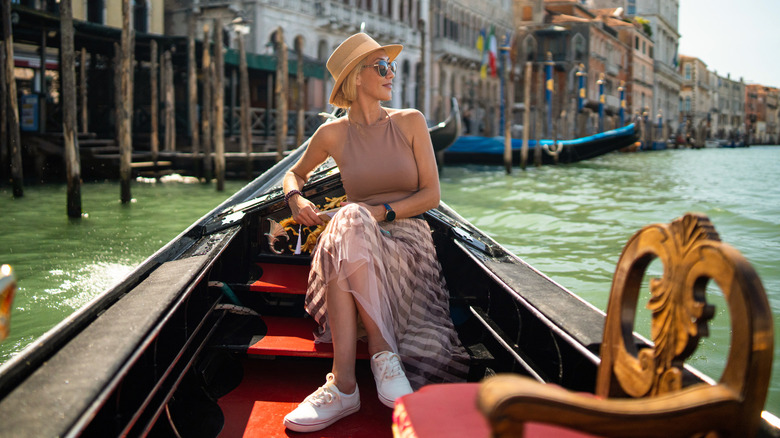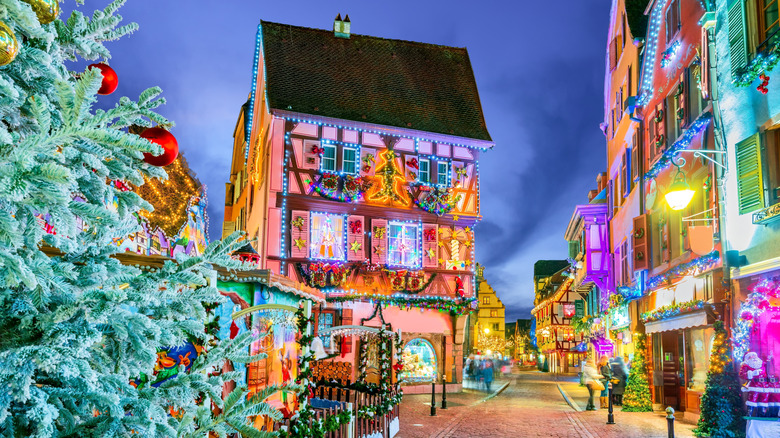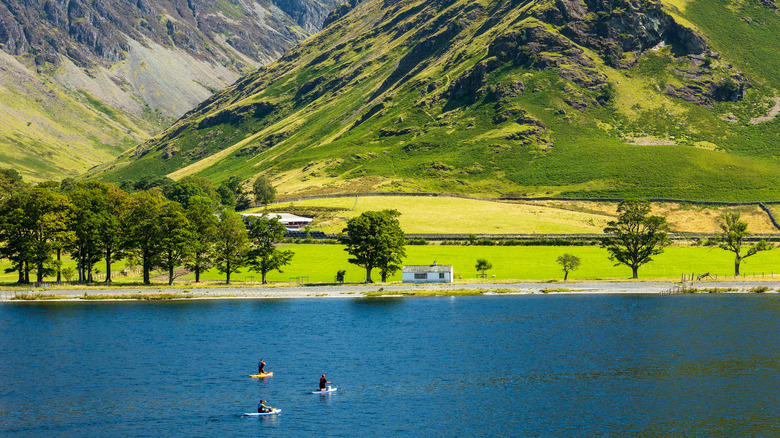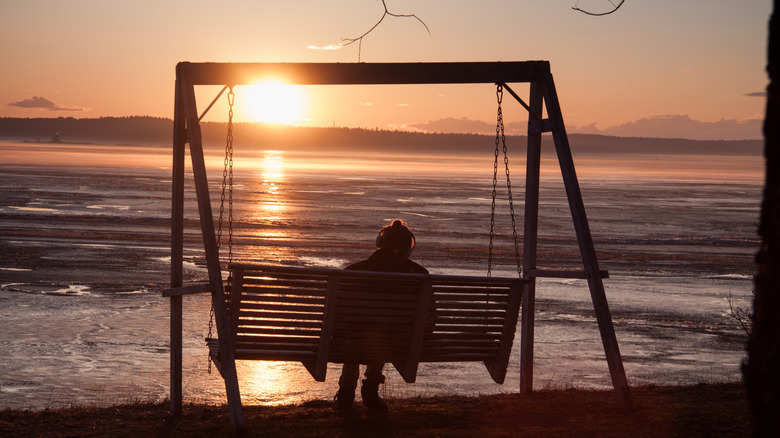Rick Steves Revealed The Best Time To Visit These Five Most Popular European Countries
Finally embarking on that much-awaited European vacation? After you've chosen the best place to visit in Europe based on your interests, it's now time for a follow-up question: When's the best time to book it? With decades of travels to Europe under his belt, we turn to the wisdom of travel guru Rick Steves, who explains in his blog "When to Go to Europe: Timing Your Trip" that timing is an important consideration when planning your adventures in Europe.
Steves describes three travel seasons on this blog — peak season, shoulder season, and off-season — each with their pros and cons. Peak season in Europe, which falls from May through September, brings bright sunny days that are perfect for outdoor activities. But Steves points out that you'll have to contend with higher numbers of fellow travelers: both foreign tourists as well as more locals on their annual vacations. During the off-season from November through March, cold and snowy weather in some areas will be both your friend and foe. Wintertime can be magical in certain cities as the Christmas holidays kick in, allowing you to experience Europe alongside locals. Yet it can also be downright dreary in January and February, that long stretch of time before warmer weather arrives. Travel can be cheap during winter, but some shops and tourist spots may be closed.
Then there's the shoulder season, which is a lovely compromise if your schedule allows it. Around April and October, temperatures tend to be mild, and tourist crowds are ebbing. However, during seasonal transition periods, the weather can be very unpredictable, and knowing what to pack can present a conundrum. Whatever your travel window, there's a destination in Europe that's ripe for exploration.
Explore Italy during the shoulder season
May, June, September, and October are the absolute best months for a vacation to Italy, according to Rick Steves. Though you may get lucky and find some good travel deals during these months Steves notes that "they're also the busiest and most expensive time to visit (with the north remaining just as busy throughout midsummer)." Italy's battle with overtourism has made headlines these past few years, so a visit during shoulder season later in October or even in late April could alleviate the strain on some of the most popular tourist spots.
Roaming the cobblestone streets of Italy's old cities and wandering through remote hilltop villages in the cool, temperate weather of the shoulder season sounds like an ideal vacation. In addition, hiking along the country's numerous nature trails or lounging on its warmer southern beaches would also be far more pleasant in early spring and late fall, minus the scorching summer heat. Another reason to visit in the fall shoulder season: Wine harvest season kicks off in autumn, opening up many more experiences for oenophiles. However, if you're traveling at this time, you need to keep an eye on the weather, which can change when you least expect it. Steves warns in his blog entry "When to Go to Italy that "many hotels aren't allowed to turn on their heat until the coldest winter months," so pack clothing that can be layered if you're planning a fall or spring visit.
France is delightfully quiet in the off-season
Ah, la France. From the pocketbook perils of the Eiffel Tower (considered the worst place for pickpockets in all of France) to the possibility of a lack of air-conditioning during a heat wave, Paris may best be left alone during peak season. But if you carefully plan around the winter closures of some cultural sites, the shorter daylight hours, and unpredictable weather, France can be a surprisingly enchanting winter destination.
While Rick Steves points out in his blog entry "When to Go to France" that spring and fall are excellent times to visit, he also makes a case for going during the off-season. He fondly recalls people-watching from a café in a "nearly tourist-free Paris" as one of his warmest off-season European memories. December through March offers a glimpse into the lives of the locals, away from the crushing mass of tourists. The big cities are calmer and quieter, prices are more affordable, and you may actually get the time to stand and contemplate an artwork in a museum without being swept away by waves of fellow museum-goers.
Off-season travel advantages can extend to the rest of France as well. December leading up to the holidays can be a magical time to experience smaller towns and provinces, when their quaint town squares are animated with twinkly lights and vibrant Christmas markets. Southern France's Côte d'Azur makes an amazing winter destination for its milder weather and cheaper prices. Like many other European destinations, accommodations in France tend to be cheaper during the off-season. "Outside of places that get lots of business travelers, hotels and Airbnb-type rentals are also less expensive, and you can sometimes even bargain for deeper discounts," writes Steves in his blog.
Spain turns on the festivities in the off and shoulder seasons
Another unfortunate victim of overtourism, Spain can be a battlefield during the peak season. Savor your sangria and tapas during spring and fall shoulder seasons, when there's the "best combination of good weather, light crowds, long days, and plenty of tourist and cultural activities," Rick Steves says in his blog entry "When to Go to Spain."
For one, a number of important festivals and events take place during the shoulder months in Spain, such as the April Fair in Seville and the bullfight performances in Madrid. Spanish cities celebrate Easter in the spring, so you can expect Semana Santa (Holy Week) processions and masses, followed by festive celebrations come Easter Sunday. Meanwhile, autumn heralds the wine harvests, so this would be the time to explore the dramatic scenery and historic charm of Spain's underrated wine regions. You may also be able to score cheaper prices for luxury hotel stays during this period, taking advantage of the lull in tourism right before the winter holiday rush.
But don't write off the winter months for a Spain visit. You won't get the sunshine you'd usually expect, and you will have to adjust to sleepier town centers or closed restaurants, but there's a buzz around the country during carnival season, with revelry building up before Lent. In his blog, Steves suggests checking out the carnivals that take place in Madrid, Barcelona, or the LGBT-friendly Sitges. Carnival dates vary according to the lunar calendar, so keep an eye out for the exact dates of the annual celebration.
The United Kingdom peaks during peak season
If you must travel in the peak season, Rick Steves gives the U.K. a thumbs-up in his blog entry "When to Go to Great Britain." Summertime is the best season to take advantage of the sunshine that graces the otherwise gray backdrop of England, Scotland, and Wales. Travel can also be surprisingly affordable. "Except during holidays and festivals, prices and crowds don't go up during peak times as dramatically in England and Wales as they do in much of Europe," Steves states in the blog.
The sunshine and good weather alone, so rare in England, make traveling in the peak season worth it. Popular hotspots like London and Edinburgh are bound to be teeming with tourists year-round anyway, so seeing them in good weather can be a delightful experience. This is the time to venture out to the beaches of Cornwall or the coast of Wales and to strap on those hiking boots to cross the rustic landscapes of the Scottish Highlands. Water sports like surfing, kayaking, or windsurfing are also available to adventure-seekers along the southern English coast; places like Fistral Beach, the Jurassic Coast, or the Isle of Wight offer these activities.
Summer in the U.K. fiercely ignites the party spirit through the number of festivals and outdoor events that take place during this period. Whether you're moshing at a Glastonbury Festival stage in June, getting swept up in the excitement of the Wimbledon finals in July, or grooving to the steel bands at the Notting Hill Carnival in August, summer is the time to party. That's not to say that you won't encounter rain during peak season — you will — so follow Steves' advice to layer up, and don't leave home without a jacket and an umbrella.
Scandinavian summers are maxed out with the midnight sun
Another destination to take advantage of during peak season is Scandinavia, which comes alive under the sun. Though this season also brings more tourists to its shores, Rick Steves writes in his blog entry "When to Go to Scandinavia" that "up here, 'crowds' mean fun and action rather than congestion." Norwegian summers can see temperatures soar to 86 degrees Fahrenheit, allowing locals and tourists to take advantage of the long daylight hours and warm water temperatures with various nature-centric activities like swimming, hiking, camping, or boating. Summer is also an active time in Sweden, which hosts several summer music festivals, while its National Day (June 6) sees a nationwide burst of celebrations.
As a summer visitor, you may not witness the northern lights, but you're in the perfect window to see the midnight sun, when the landscape gets tinted in stunning tones of red, yellow, and gold all day and into the night. In Norway, head north (e.g., to the Lofoten Islands, North Cape, or Kirkenes) to experience this natural summer phenomenon, where sunset and sunrise seemingly blend into each other, lingering in the sky. If you're in Sweden, you're assured front-row seats for the midnight sun in Abisko and Kebnekaise. Steves notes in his blog that Scandinavian cities tend to quiet down by the end of August, when children head back to school.





